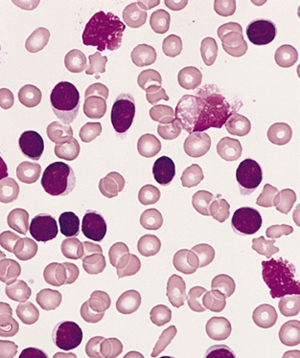Immunotoxin Effectively Targets B-Cell Malignancies
In a phase I trial, DT2219, the novel bispecific ligand-directed toxin, has shown activity against relapsed and refractory B-cell lymphoma and leukemia.
Bone marrow showing B-cell chronic lymphocytic leukemia

In a phase I trial, DT2219, a modified diphtheria toxin bound to a variable fragment of antibodies targeting CD19 and CD22, has shown activity against relapsed and refractory B-cell lymphoma and leukemia. The results of this trial were published in Clinical Cancer Research.
Two of the 10 patients who could be evaluated had durable objective responses, with one complete remission after two cycles of therapy.
“We were surprised that the drug was effective enough to entirely eliminate the cancer in one of our patients,” said study author Daniel A. Vallera, PhD, of the department of radiation oncology at the University of Minnesota in Minneapolis, in a statement.
Dr. Vallera and colleagues enrolled 25 chemo-refractory patients with previously treated pre-B acute lymphoblastic leukemia, chronic lymphocytic leukemia, or non-Hodgkin lymphoma whose tumors expressed CD19 and/or CD22. Eight patients had previously undergone unsuccessful bone marrow transplantations. Patients had a median of three prior therapies and their median age was 55 years.
DT2219, a recombinant fusion protein, is made up of the catalytic and translocation enhancing domain of the diphtheria toxin fused with bispecific single-chain variable fragments (scFV) of antibodies to CD19 and CD22. Prior preclinical studies showed that this immunotoxin resulted in efficient toxin delivery and had greater anti-tumor activity compared with monomeric anti-CD19 or anti-CD22 connected with truncated diphtheria toxin.
The anti-CD19 and anti-CD22 antibody fragments bind to the malignant B cells and are taken up by the cell, resulting in cell killing by the diphtheria toxin.
The initial results of this trial were first presented at the 2014 American Society of Hematology Annual Meeting.
All patients received a single cycle of the immunotoxin therapy at varying doses between 40 and 80 µg/kg administered as four intravenous infusions for 2 hours every other day.
The most common adverse events were low albumin, weight gain, transaminitis, and fever. These events were transient and were generally grade 1 or 2 in the patients treated at higher doses (≥ 40 µg/kg per day).
Two patients had a dose-limiting toxicity with the 40- and 60-µg/kg doses.
The patient who achieved complete remission had relapsed CD19-positive, CD22-positive diffuse large B-cell lymphoma and was treated with the 60-µg/kg dose.
Neutralizing antibodies against the bacterial toxin were only detected in 30% of the patients. These antibodies can lead to rejection of the drug. According to Vallera, more work is needed to understand why most patients did not develop these antibodies, and a phase II clinical trial with more cycles of DT2219 is currently being planned.
Highlighting Insights From the Marginal Zone Lymphoma Workshop
Clinicians outline the significance of the MZL Workshop, where a gathering of international experts in the field discussed updates in the disease state.